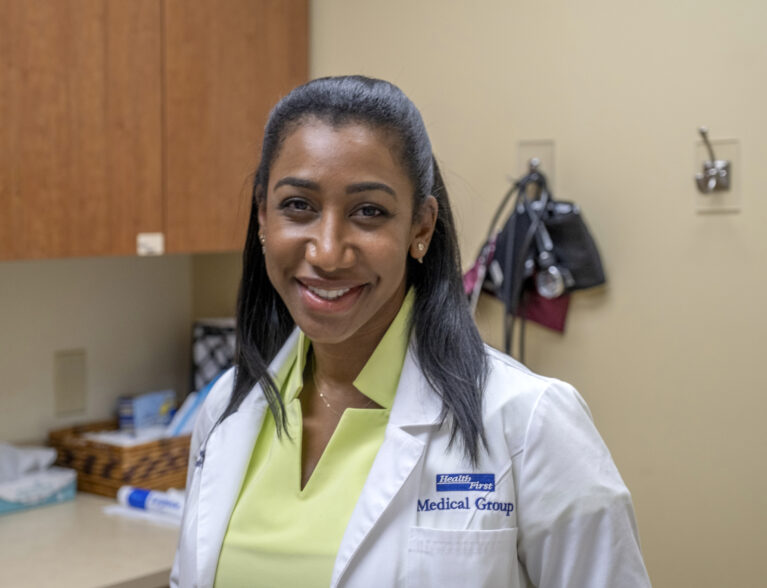
Although research shows that up to 70 percent of women will develop uterine fibroids during their reproductive years, there’s still a surprising lack of knowledge about the condition among women. Fortunately, fibroids are harmless 99 percent of the time, in and of themselves, but they can cause complications like excessive bleeding and reproductive problems and shouldn’t be ignored.
Tasscia Williams-Souffrant, MD, a board-certified OB/GYN at Health First Medical Group in Melbourne, says that women often overlook symptoms of fibroids, believing they’re just a normal occurrence. “Do you feel bloated? Has your menstrual blood flow changed in any way? Women assume these changes are nothing to be concerned about, but that’s not necessarily the case,” she said.
Other common symptoms of fibroids include back and pelvic pain, frequent urination, constipation, and pain during sex.
Despite the fact that these non-cancerous growths affect millions, a widespread lack of awareness exists. To help remedy that, in 2020 the Uterine Fibroid Research and Education Act was introduced to provide funding for research and educational programs for women.
Cleveland Clinic explains that fibroids can grow as a single nodule (one growth) or in a cluster. They can be as small as a seed or as large as a watermelon and can develop within the wall of the uterus, inside the main cavity of the uterus, or on the outer surface.
Although many women affected don’t know they have fibroids, one of the most significant side effects is interference with conceiving. Fertility may be affected if the uterus and/or fallopian tubes are blocked by fibroids, which can make it difficult to get pregnant or may put any subsequent pregnancy at risk for miscarriage or early labor.
Dr. Williams-Souffrant emphasizes the importance of an annual visit with your OB/GYN since it’s so common for fibroids to be asymptomatic. They are often found by chance during a routine pelvic exam.
Ultrasound, blood tests and MRIs are some of the tests your doctor will order to determine if you do have fibroids.
Risk factors include:
- Age (older women are at higher risk than younger women).
- Obesity.
- Family history of uterine fibroids.
- High blood pressure.
- No history of pregnancy.
- Vitamin D deficiency.
- Food additive consumption.
- Race (African American women have higher rates of occurrence).
Lifestyle changes can lessen symptoms or prevent the formation of fibroids altogether. Dr. Williams-Souffrant advises that hypertension and obesity both can aggravate the condition, as can alcohol consumption and an unhealthy diet.
Web MD adds the following suggestions that can either lessen your symptoms or lower your risk:
- Eat plenty of fruits like apples and tomatoes, and cruciferous vegetables like broccoli and cabbage. Don’t eat a diet full of processed foods, red meats and high-fat dairy. Studies show these foods can make your fibroids worse. The same goes for caffeine, and don’t overdo it on the sugar.
- Research has shown a strong link between fibroids and high blood pressure.
- Some research suggests stress and fibroids may be linked. Try relaxation techniques such as deep breathing, yoga, massage and tai chi to help manage your stress.
- If you’re having painful periods because of your fibroids, try lying down and elevating your legs with a pillow. Or lie on your side and bring your knees into your chest to take the pressure off your back.
- There is some research that suggests supplements like vitamin D can help lower your risk for fibroids, but check with your doctor first.
- Don’t skip your workouts and exercise.
- Don’t smoke.
There are many treatment options available for women with fibroids, according to the Yale Medical School website. They include:
- Hormonal therapy and/or low-dose birth control pills.
- For small fibroids, a hysteroscopy (inserting a hysteroscope into the vagina to remove the fibroids) can be done in a short outpatient procedure.
- For larger fibroids, women can have a laparoscopic myomectomy, in which a surgical instrument is inserted through the navel to remove the fibroid. This can also be done with the assistance of a robot.
- Women who have completed their families or aren’t interested in having children can opt for a hysterectomy (removal of the uterus).
- Women can also choose to have a uterine artery embolization, which is noninvasive and offers a faster recovery than surgery. The artery is entered through the groin or from the wrist and small particles are injected into the bloodstream around the fibroid, causing it to shrink.
Dr. Williams-Souffrant urges all women to see their OB/GYN on a regular basis so that fibroids can be identified and treated when necessary, preventing fertility problems and improving quality of life.
Tasscia Williams-Souffrant, MD, OB/GYN, is board-certified and fellowship trained in minimally invasive gynecologic surgery. She completed her residency at Nassau University Medical Center in East Meadow, N.Y., and earned her medical degree from Ross University School of Medicine in Portsmouth, Dominica W.I. She also has a Master of Public Health degree from Emory University’s Rollins School of Public Health in Atlanta. She is accepting new patients at Health First Medical Group-Gateway, 1223 Gateway Dr., Suite 1D, Melbourne. The phone number is 321-434-3131.



